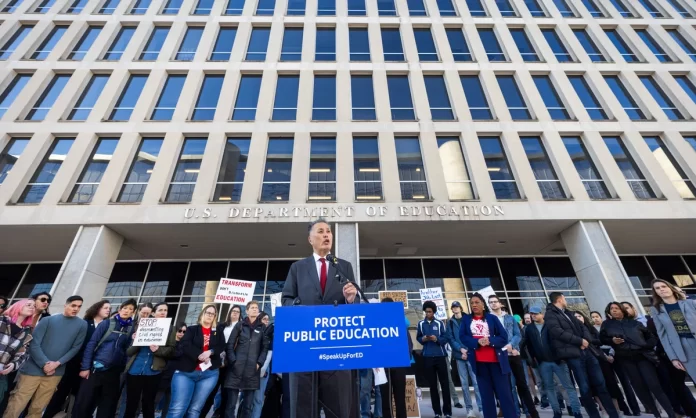On March 11, 2025, U.S. Department of Education staff cuts a substantial number of its employees by laying off around 50% of its staff. This move is part of President Trump’s plan to reorganize federal operations and reduce the size of government. The Department of Government Efficiency (DOGE), headed by Elon Musk, has played a key role in these initiatives by targeting numerous federal agencies for consolidation.
Context and Rationale.
This view holds that local institutions are more capable of managing educational needs without the intervention of the federal government.
Impacted Functions and Services.
The firings have created fears regarding the continuity of critical services. The Office of Federal Student Aid (FSA) cut over 300 staff handling loans and inquiries, raising concerns about disruptions for borrowers, who could encounter greater challenges in navigating repayment and forgiveness programs. Despite assurances by the administration that vital functions like student-loan servicing will proceed without disruption, distrust is still on high alert. The Institute of Education Sciences (IES), the research arm of the ED, has also been hit with reduced funding by $881 million, which resulted in stalled research studies and broken contracts. This occurrence gives one reason to question the future of education research and evidence-based policy-making.
U.S. Department of Education staff cuts
Reactions from Stakeholders.
The move has drawn mixed responses. Former Education Secretary Miguel Cardona denounced the layoffs, citing concerns over their adverse effects on public education. He emphasized possible difficulties in dispersing Title I funding, serving students with disabilities, implementing accountability for predatory schools, and handling federal Pell Grants. Cardona criticized the administration’s attempt to dismantle the department and privatize education, calling on educators to stay committed to serving students and public schools.
Education groups and Democrats argue the cuts could disrupt students, scholarship programs, and civil rights enforcement. Despite the cuts, Secretary McMahon pledged that basic services, including issuance of Pell Grants and student loans, would continue. The administration’s plan to close the agency needs 60 Senate votes, requiring further action before the department can shut down.
Broader Implications.
The ED’s reduction in force is a part of an overall federal downsizing initiative. Other agencies, including the Department of Veterans Affairs (VA), National Oceanic and Atmospheric Administration (NOAA), and Internal Revenue Service (IRS), are also undergoing extensive layoffs. The VA, for example, intends to eliminate 80,000 positions, igniting protest because a large portion of its workforce is comprised of veterans. NOAA will reduce its workforce by 10%, which is essential to forecasting weather and responding to disasters. The IRS may cut up to 45,000 jobs, including recent layoffs and reassignments, to support immigration enforcement.
Conclusion.
As events unfold, the tension between efficiency and provision of critical educational services is at the center of national debate.
Read More:- The Importance of a Financially Empowered Workforce in Business Success.
Reference:- https://www.theguardian.com/us-news/2025/mar/11/us-education-department-layoffs





